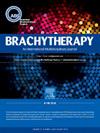3d打印模板设计,以提高125I种子菌斑组装精度为葡萄膜近距离治疗。
IF 1.7
4区 医学
Q4 ONCOLOGY
引用次数: 0
摘要
目的:展示种子定位质量保证程序的实用性,并设计一个 3D 打印模板,以提高用于葡萄膜近距离治疗的定制 125I 眼斑上种子放置的准确性:在 MATLAB 中开发了一个种子定位分析工具 (SLAT),用于检测相对于治疗计划的种子位置变化。在 CAD 中设计了一个灵活的种子放置模板 (3D-FSPT),并使用 Formlabs Form-3 3D 打印机打印出来。3D-FSPT 和 SLAT 使用 3D 打印的模型眼部斑块进行了测试,其中的非放射性种子按照临床相关的治疗计划进行了排列。同时还对五个临床斑块进行了评估:结果:SLAT 检测出种子位置的亚毫米级变化,相对于计划的种子坐标误差为 2.3%,不确定性为 ± 0.01 毫米。自由放置种子的模型斑块上种子的平均位移为 1.31 毫米(SD = 0.61),种子的平均方向差异为 5.27 度(SD = 4.77)。临床斑块上的平均种子位移为 0.77 毫米(标度 = 0.42),平均种子方向差异为 4.41 度(标度 = 3.00)。对于临床斑块,肿瘤顶点和关键眼部结构的剂量测定变化在可接受的容差范围内。粒子位移(毫米)(p 结论:粒子位移(毫米)(p3D-FSPT和SLAT在提高相对于治疗计划的种子放置准确性方面的可行性得到了证实。本文章由计算机程序翻译,如有差异,请以英文原文为准。
3D-printed template design to improve 125I seed plaque assembly accuracy for uveal brachytherapy
Purpose
To demonstrate the utility of a QA program for seed localization, and to design a 3D-printed template to improve the accuracy of seed placement on custom-built 125I eye plaques for uveal brachytherapy.
Methods and Materials
A seed localization analysis tool (SLAT) was developed in MATLAB to detect variations in seed placement relative to a treatment plan. A flexible seed placement template (3D-FSPT) was designed in CAD and printed using a Formlabs Form-3 3D printer. The 3D-FSPT and SLAT were tested using 3D-printed model eye plaques with nonradioactive seeds arranged following clinically-relevant treatment plans. Five clinical plaques were also evaluated.
Results
SLAT detected submillimeter scale variations in seed position with 2.3% error relative to the plan's seed coordinates, and with an uncertainty of ± 0.01 mm. The average seed displacement on the model plaques with free-handed seed placement was 1.31 mm (SD = 0.61), and the average seed orientation difference was 5.27 degrees (SD = 4.77). The average seed displacement on the clinical plaques was 0.77 mm (SD = 0.42), and the average seed orientation difference was 4.41 degrees (SD = 3.00). For the clinical plaques, changes in dosimetry to the tumor apex and critical eye structures were within acceptable tolerances. Seed displacement (mm) (p < 0.001) and seed orientation differences (degrees) (p = 0.008) were significantly lower using the template to guide seed placement on the model plaques compared to free-handed seed placement.
Conclusions
The feasibility of a 3D-FSPT and SLAT is demonstrated for improving seed placement accuracy relative to a treatment plan.
求助全文
通过发布文献求助,成功后即可免费获取论文全文。
去求助
来源期刊

Brachytherapy
医学-核医学
CiteScore
3.40
自引率
21.10%
发文量
119
审稿时长
9.1 weeks
期刊介绍:
Brachytherapy is an international and multidisciplinary journal that publishes original peer-reviewed articles and selected reviews on the techniques and clinical applications of interstitial and intracavitary radiation in the management of cancers. Laboratory and experimental research relevant to clinical practice is also included. Related disciplines include medical physics, medical oncology, and radiation oncology and radiology. Brachytherapy publishes technical advances, original articles, reviews, and point/counterpoint on controversial issues. Original articles that address any aspect of brachytherapy are invited. Letters to the Editor-in-Chief are encouraged.
 求助内容:
求助内容: 应助结果提醒方式:
应助结果提醒方式:


